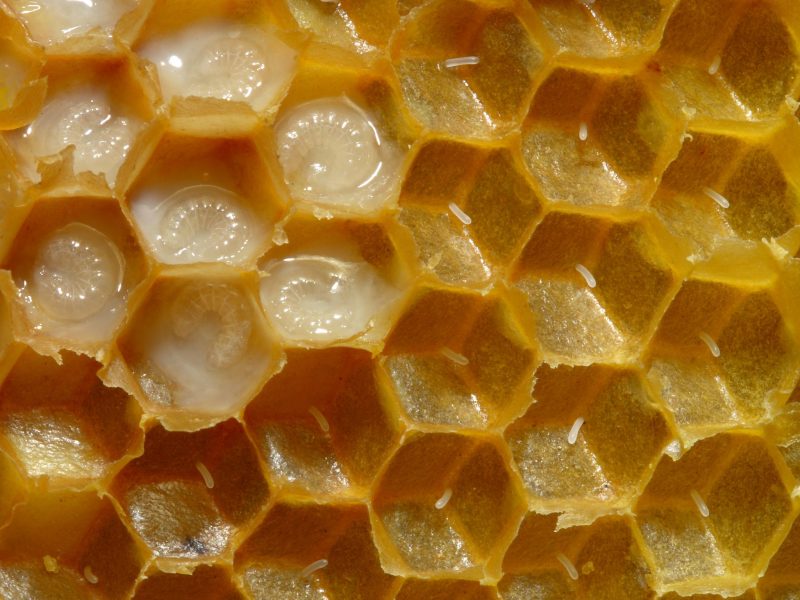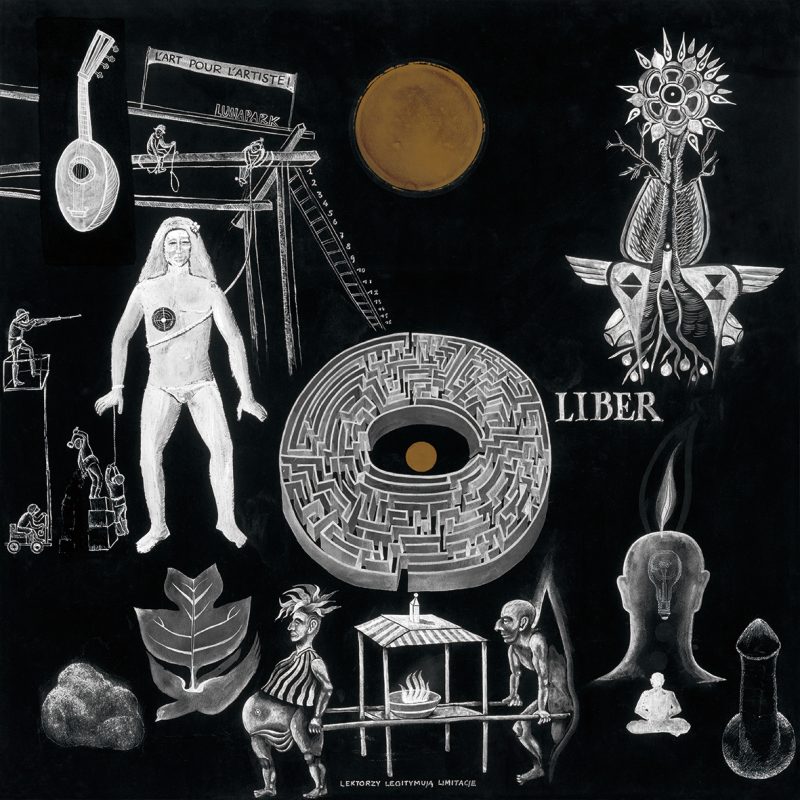
Marta Kudelska
ON THE ROMANTIC TURN IN POLISH ART. MODERN ART AND THE ROMANTIC TRADITION – AN OVERVIEW OF THE ISSUES
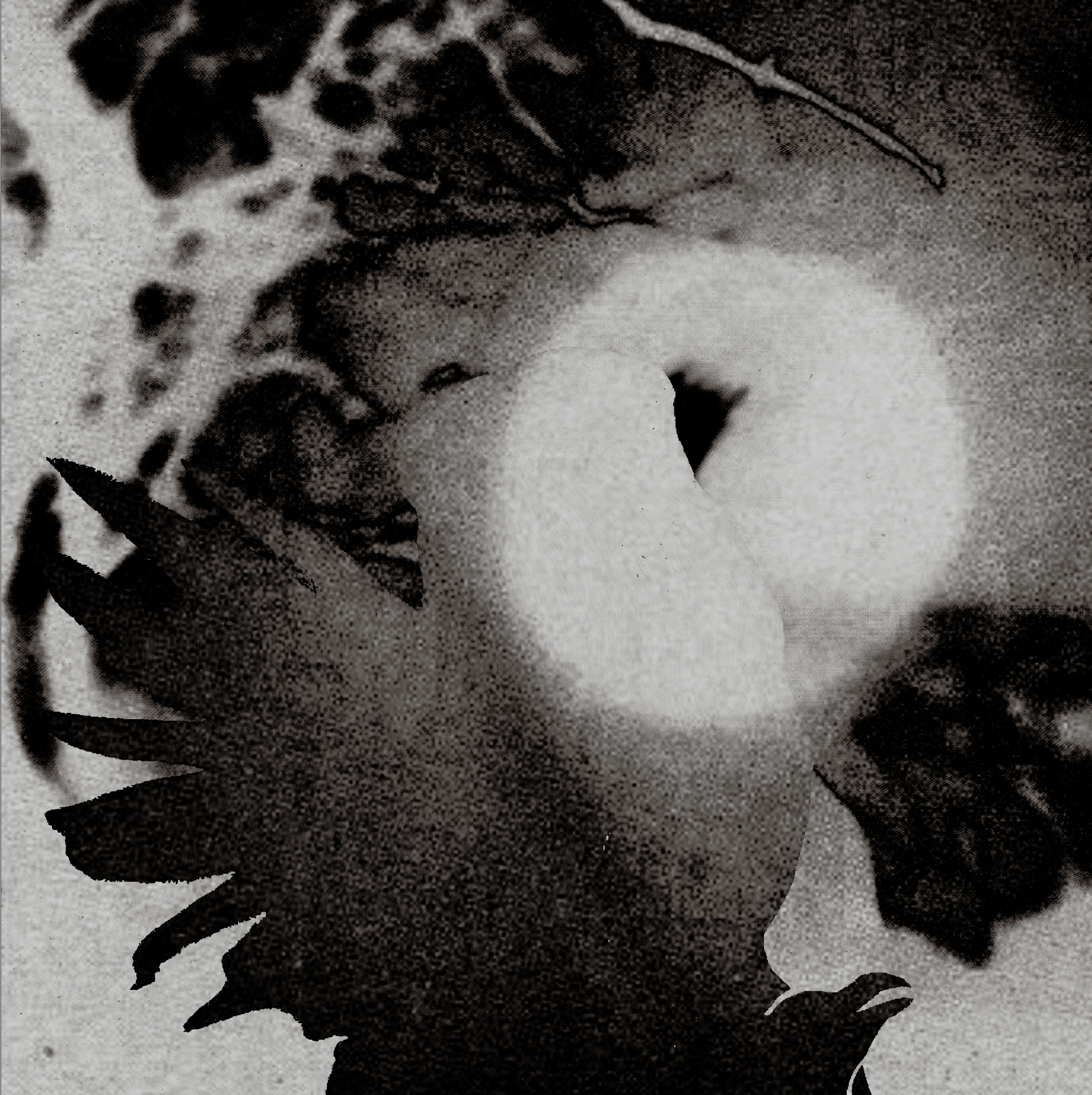
Drawing by Michał Bratko
Art referring to themes associated with romanticism, such as: magic, eeriness, spiritualism, and esotericism, increasingly becomes a clearly present phenomenon in the Polish art scene. Inspirations drawn from these themes assume various forms, pervade a variety of artistic stances and haunt a range of media. The diversity of motifs dealt with in this field of art is obviously rooted in the age of romanticism, when these were manifested in the culture breaking away from the Enlightenment framework of classicising and mimetic art. However, before I focus on the main part of my paper, that is, the romantic inspirations in the art of young contemporary artists, I would like to emphasise one point. In this text, I am not interested in romanticism as stereotypically understood: an attitude embracing the notions of messianism, Prometheanism, and national liberation. Instead, I am interested in Romanticism as a worldview based on the darker, more mysterious and phantasmic side of reality. Thus, I do not intend to shroud contemporary artists in ‘the mantle of Konrad’, but I do want to accompany them in approaching The Castle of Otranto. More than in the conspiracies of Philomaths and Philarets, I am interested in the mysterious rituals in the spirit of dziady (Forefather’s Eve). Whereas, more than in the figure of Prometheus, I am interested in Morgan le Fay. What entices me in the romantic experience is rather the unfulfilled contact with the past, eeriness and magic, than in romantic prophetism. And what becomes the crucial question for me is how young artists refer to the so-called dark romanticism.1
Why should I be interested in this less obvious side of romanticism and its relation to young art? In the summer of 2018, when I was preparing the exhibition Madam, can you check if there are any dreams tangled in my hair?, the first part of The Black Trilogy, little did I expect the sheer immensity of the material I was about to go through. The cycle marked an attempt at conceptualising my curatorial and academic interests, centred around something that – for my own use – I called ‘the romantic motif’ in Polish art. When selecting artists for these exhibitions, I did not suppose that I would soon start to include in the category an ever growing number of names and individual works of the most modern art. The more time I devoted to my curatorial search, the more I was beginning to observe, contrary to Maria Janion’s theory of the twilight of the romantic paradigm in the Polish culture after 1989,2 that it had never been exhausted.
In the recent years, we have been able to observe the turn towards art evoking such mysterious, magical, and, at times, terrifying content. In fact, even if we take a perfunctory glance at the past, motifs of this kind will prove to have been far more numerous than we might have initially supposed, and they reach far beyond the historical period of romanticism. The romantics themselves were fascinated by everything anachronistic: old castles, deserted mansions, graves swathed in fog and hidden in forests, as well as by the belief that the way to understand their world was to turn to uncharted territories: the Orient, the East, which the romantics saw as an extraordinary and magical place. They were attracted to the nature, the countryside, the rituals fostering micro-communities and to their beliefs, which they regarded as the cure for the alienated and increasingly modern world. An intrinsic element of the Gothic, dark side of romanticism was the experience of death, which constituted a natural component of reality. The romantic transgression manifested a downright pathological fascination with darkness, lunacy, vampirism, occultism, and spiritism.3 Obviously, this dark facet of reality was located in the wild, unbridled East, the seat of chaos, of most varied apparitions, but also of the almighty ancient Slavonic deities and spectres. Hence, the European East was not only a cruel and threatening place, but also one evading the rationalisation of the classical perception of the world. A certain grotesqueness of such a presentation led to the romantic belief that the world was ruled by impersonal, supernatural powers which are only kept in check by the delicate thread of rationality. Romantics were unable to leave behind spectres and the undead – after all, it was because of these that they could maintain a state of permanent melancholy, which resulted from the never fully satisfied need to be in contact with the past.4
This attitude, so typical for romanticism, found continuation not only in the sentimentalism of the Young Poland movement, but also in the works of artists identified with the great avant-garde. In fact, their attitude to Romanticism is not as obvious as it might initially seem notwithstanding the fact that Władysław Strzemiński in his essay ‘Konieczność walki z upiorami romantyzmu’ (The Need to Fight the Spectres of Romanticism)5 called for doing away with the problematic figure of the artist-genius, which he believed to be at odds with the social engagement of modern art. This did not mean that the avant-garde had no use for references to romanticism.6 The spectral march of eerie and romantic motifs through art can be observed – contrary to Strzemiński’s apprehensions – in the avant-garde of the twentieth century. Such a surreal and uncanny, and sometimes ghastly sensitivity marks the oeuvre of Maria Anto, Erna Rosenstein, Władysław Hasior, and Janina Kraupe-Świderska, who hails from the milieu of the Polish counter-cultural group Oneiron, as well as the primitivists from the Janów Group. In Poland, romanticism was also echoed in actions performed towards the end of the Polish People’s Republic (PRL): in Manifestacje romantyczne (Romantic Manifestations) by Jerzy Bereś, or exhibitions Polaków portret własny (Poles’ Self-Portrait), and Romantyzm i romantyczność, curated by Marek Rostworowski. Worth mentioning at this juncture is the curatorial activity of Janusz Bogucki, who clearly referred to the romantic need for spirituality and sense of community. An important place in this history is also due to the phenomenon of the new expression of the 1980s. The continuation of the wave of romantic attitudes came in the form of the 1990s exhibitions held in the Ujazdowski Castle Centre for Contemporary Art, such as Magowie i mistycy (Magicians and Mystics).
Traces of the latter exhibition – in spite of the aforementioned thesis of the twilight of the romantic paradigm in Polish culture, which was supposed to have occurred in the 1990s – we can also find in the artistic stance of creators identified with the so-called critical art: Zbigniew Libera, Paweł Althamer, Alicja Żebrowska, or in the prophetism of Artur Żmijewski, particularly in view of his manifesto Stosowane sztuki społeczne (The Applied Social Arts). In later years, the issues related to a kind of surreality would return to the idiom of contemporary art thanks to those who were ‘the tired of reality’,7 known also as ‘the new surrealists’: Jakub Julian Ziółkowski, Przemysław Matecki, and Paweł Śliwiński. Curiously enough, their art was attributed to the surrealist turn, not to romanticism, a movement which had not only inspired the surrealists but had been the first to embrace so strongly the role of imagination. I would like, however, to merely signal this issue, as confirming or disproving it would require more thorough research.
The longevity of the romantic outlook in the most recent Polish art is evidenced by exhibitions, such as: Manifestacje romantyczne (Romantic Manifestations) (bwa Sokół in Nowy Sącz, 2014), Dzieci Szatana (The Children of Satan) (National Museum in Krakow, 2018), Nietota (Northern Firmoss) (Wrocław Contemporary Museum, 2018), Dzieci światła (Children of Light) (Galeria Bielska bwa in Bielsko-Biała, 2018), slavica (Grey House Gallery in Krakow, 2018), A Dream Within a Dream (curatorial duo dzidy, exhibition in a garden in Warsaw, 2020), W czarodziejską burzę włożę własną duszę (I Will Put My Soul into the Magic Storm) (bwa Warsaw, 2020), Magiczne zaangażowanie (Magical Engagement) (Municipal Gallery Arsenał in Poznań, 2020), Salon odnowy magicznej (Magical Wellness Spa) (Widna Gallery in Krakow, 2021), W te dni zgiełkliwe, płomienne i oszałamiające, przenoszę się myślą (In These Days of Tumult, Heat and Dazzle I Retreat In My Mind) (The Stefan Gierowski Foundation in Warsaw, 2021), Ziemia znowu jest płaska (The Earth Is Flat Again) (Muzeum Sztuki in Łódź, 2021), Ciemności kryją ziemię (Darkness Covers the Earth) (bwa Warsaw, 2022), as well as the exhibitions by the ‘classics’, who deal with art drawing on spiritual and esoteric experiences: Urszula Broll. Atman znaczy oddech (Atman Means Breath) (Sculpture Museum in Królikarnia Palace, 2020), or Harmonia Mundi. Henryk Waniek (Gallery of Contemporary Sacred Art ‘Dom Praczki’ in Kielce, 2020).
As for the theoretical reflection on the Romantic inspirations in contemporary art, it remains sparse. Romantic motifs are touched upon in a rather short booklet by Andrzej Banach O polskiej sztuce fantastycznej (On Polish Fantasy Art),8 which is focused, however, rather on the fantasy-filled tales in art. A mention is due to the articles Między nienawiścią do demokracji a współpracą (Between Hatred Towards Democracy and Cooperation) by Ewa Majewska,9 Dziady polskie, czyli o wcieleniach niesamowitego w polskiej kulturze (Polish Forefather’s Eve Or On the Incarnations of the Eerie in Polish Culture) by Agata Pyzik,10 Zwyczajne, niesamowite (Ordinary, Ghastly) by Adam Mazur,11 Duchy, upiory, wampiry (Ghosts, Spectres, Vampires) by Izabela Kowalczyk.12 It is not, of course, the entire bibliography on the issue; however, the latter does not span many publications.
For this very reason, I would like to use this paper to make an attempt at signalising the dark, mysterious, magical tropes and motifs emergent in recent years. The basic categories I am going to use in order to illustrate this topic will be: the past, eeriness, and magic, in that order. At the same time, I would like to emphasise that neither the list of artists presented here nor the conclusions drawn exhaust the issue at hand, they merely mark a stage in my both curatorial and scholarly exploration. When building upon art created here and now, we must remain attentive, but also let ourselves be surprised. This paper is an effort to outline a phenomenon which tells us not only about art, but also about the reality in which we happen to be living.
THE PAST
The increasing number of romantic accents in the Polish art of the recent years can be clearly seen in the oeuvres of Jakub Woynarowski, Wojciech Ireneusz Sobczyk, and Ewa Juszkiewicz. Besides the mysterious and sensual aura pervading their works, the above artists also share a particular attitude towards the past, an attitude the trio inherited from the romantics.
In their 1978 book Romantyzm i historia (Romanticism and History),13 Maria Janion together with Maria Żmigrodzka attempted to reconstruct in detail the relationship between the romantic experience of the past and the culture of that period. For the romantics, history not only constituted a source of inspiration, but it was also a process by which the Hegelian march of the spirit could lead to the emancipation of the individual. Furthermore, it was also only through history – understood not as something closed and complete, but as a continuously self-shaping process – that a revolutionary change would occur. It could refer both to events that transform reality, and to something that Janion calls ‘restoration of meanings’.14 It is a concept consisting in incessant actualisation of existing cultural creations and scouring the past for neglected and marginalised phenomena that could prove significant for the present.
The strategy described above is a typical feature in the art of Jakub Woynarowski, filled with mysterious, magical symbols, signs and references to forgotten parts of art history. For many years now, Woynarowski has been gathering materials on what he refers to as an ‘alternative history of art’,15 in which he associates avant-garde art with that created in the fifteenth and the sixteenth centuries. At the same time, he indicates that these seemingly diverse stylistics interpenetrate. Woynarowski’s art manages to intertwine figures such as: Kazimir Malevich, Alexander Rodchenko, Lorenz Stoer, Wenzel Jamnitzer, and Hans Lencker. The artist is fascinated by the mysterious phenomena of Freemasonry and alchemy, but also artists and currents that never made it into the broadly understood canon of art. In many interviews, he points to parallels between the world of art, alchemical processes, and magical thinking.16 The works by Woynarowski are reminiscent of a frame-tale narrative, strikingly similar to The Manuscript Found in Saragossa by Jan Potocki, in which every element has a hidden meaning. Woynarowski himself is akin to a creator of a crazy cabinet of curiosities that stores the most diverse of elements, concurrently trying to use them in order to illuminate the connections between modern and older art.
Such an eerie aura, ingeniousness and inspiration drawn from the past find continuation in the oeuvre of Wojciech Ireneusz Sobczyk. Sobczyk, much like Woynarowski, appears to be an ‘uncontemporary’ artist.17 In his works, the old representations are extremely affective and sensual, precisely as in the installation displayed in the Office of Art Exhibitions (bwa) in Tarnów at the exhibition Wielcy sarmaci tego kraju / Wielkie sarmatki tego kraju (The Great Sarmatian Men of This Country / The Great Sarmatian Women of This Country) in 2018, inspired by the painting Danse Macabre from the Bernardine Church in Krakow.
Under a black, mournful cloth, the artist placed contemporary interpretations of Sarmatian coffin portraits, beside which, in the centre, is a black and white variation on the theme of dance macabre. On a closer look, Sobczyk’s work turns out to present the faces of these figures covered in maggots, more like decaying corpses than representative portraits of the nobility. Such a representation transports us to the very core of the romantic turn in contemporary Polish art: with its blurred boundary between life and death, the representation and the actual past, the real and the fanciful, the dead and the undead. There can be no simple separation of these oppositions: looking at the past, we always oscillate between spectres that we try to materialise to define our present – even if they turn out to be no more than a cluster of imaginings and phantasms.
At this juncture, a mention is due to Ewa Juszkiewicz. Her painting also features very powerful references to the – revelling in the past – romantic aesthetics, but also to an attitude of treating the past as a living and inspiring phenomenon. In her paintings, Juszkiewicz plays with iconic and classical representations of women. She takes away their faces, the only extant element of their individual personality. Instead, she provides her heroines with masks, bouquets of flowers, the thorax of insects, or imaginatively draped fabrics. Her paintings bring to mind the fascinating but simultaneously ghastly gallery of female portraits, who had been deprived of their voices long, long ago and are able only to look at their contemporaries. Juszkiewicz searches for nuance in the representations of women of the olden days: an unruly lock of hair, a fold on a smoothened dress – that is to say, a detail that could tell us something about the portrayed female. For the artist, such a crack, such a defiant element becomes the origin of a new story, drawing on the aforementioned notion of ‘restoration of meanings’. Juszkiewicz changes the women presented in old paintings, she transforms them from hazy spectres into powerful phantasms, who possess a special power of breaking the existing order of things through the sheer power of imagination. Thus, what the artist studies is not only traditional imagery, but also how it influences our contemporaneity, for it is from the current point of view that we interpret the past events. Furthermore, by seeking female artists overlooked in the mainstream of the traditional history of art, Juszkiewicz not only falls within the notion of herstory, but also the romantic attitude of invalidating the established canons and the principles underlying our reality.
Woynarowski, Sobczyk, and Juszkiewicz create some of the possible interpretive paths not only for the presence of romanticism in contemporary art, but also in our modernity. By referring to old stylistics, which used to be marginalised or forced into the category of conservative, commercial art by the revolutions of the avant-garde, in a sense these artists demystify our concept of modernity. Their art is akin to romantic hallucination, where we approach another category I am interested in here – that of eeriness. The latter, in fact, is also founded upon the game that Woynarowski, Sobczyk, and Juszkiewicz are involved in. It is the game of blurring-clarifying-remembering that the spectres of Romanticism, while haunting us, invite us to engage in with them.
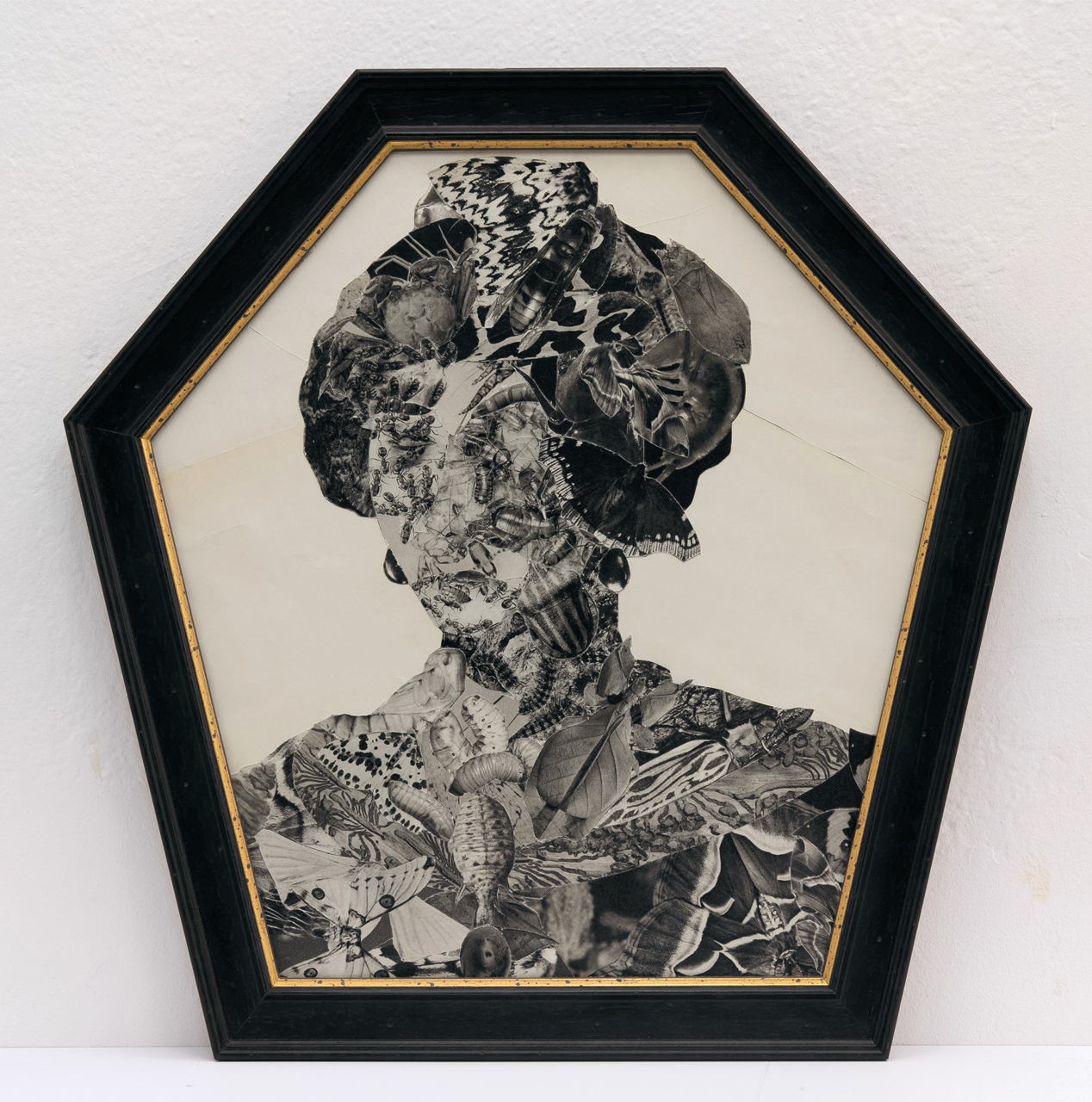
Wojciech Ireneusz Sobczyk, Coffin Portrait V from the Danse Macabre series, collage, 2018, 54 × 53 cm; photograph by Bartosz Górka
EERINESS
A Gothic, eerie convention was among those particularly embraced by the romantics. Romantic culture and romantic art were suffused with various apparitions, spectres, ghosts, and demons. Contacts with those who ‘were not allowed a proper burial’,18 constituted the basis for the romantic existence and experience of the world. A reference to this slightly ghastly aesthetics enabled romantics to capture the shortcomings of the reality around them, while at the same time to avoid apparent rationality and critical moralism.
The turn towards the aesthetics of eeriness and dread in contemporary art is, obviously, requires stepping on thin ice: one can very easily be accused of using straight kitsch from C-class horror movies. Very often such stylistic references and themes result in an artist being suspected of having no intellectual boundaries, or cakewalking, ostentation, and moralism. However, even such idiosyncratic matter as ghastliness and the focus on dread can be translated into stories being an important voice in modern times. In the oeuvre of some contemporary artists, one is able to trace recurring motifs from this imagery. Their art is filled with dancing skeletons, apparitions, spectres, ghosts, vampires, but also cemeteries, graves and other elements associated with funerary rituals.
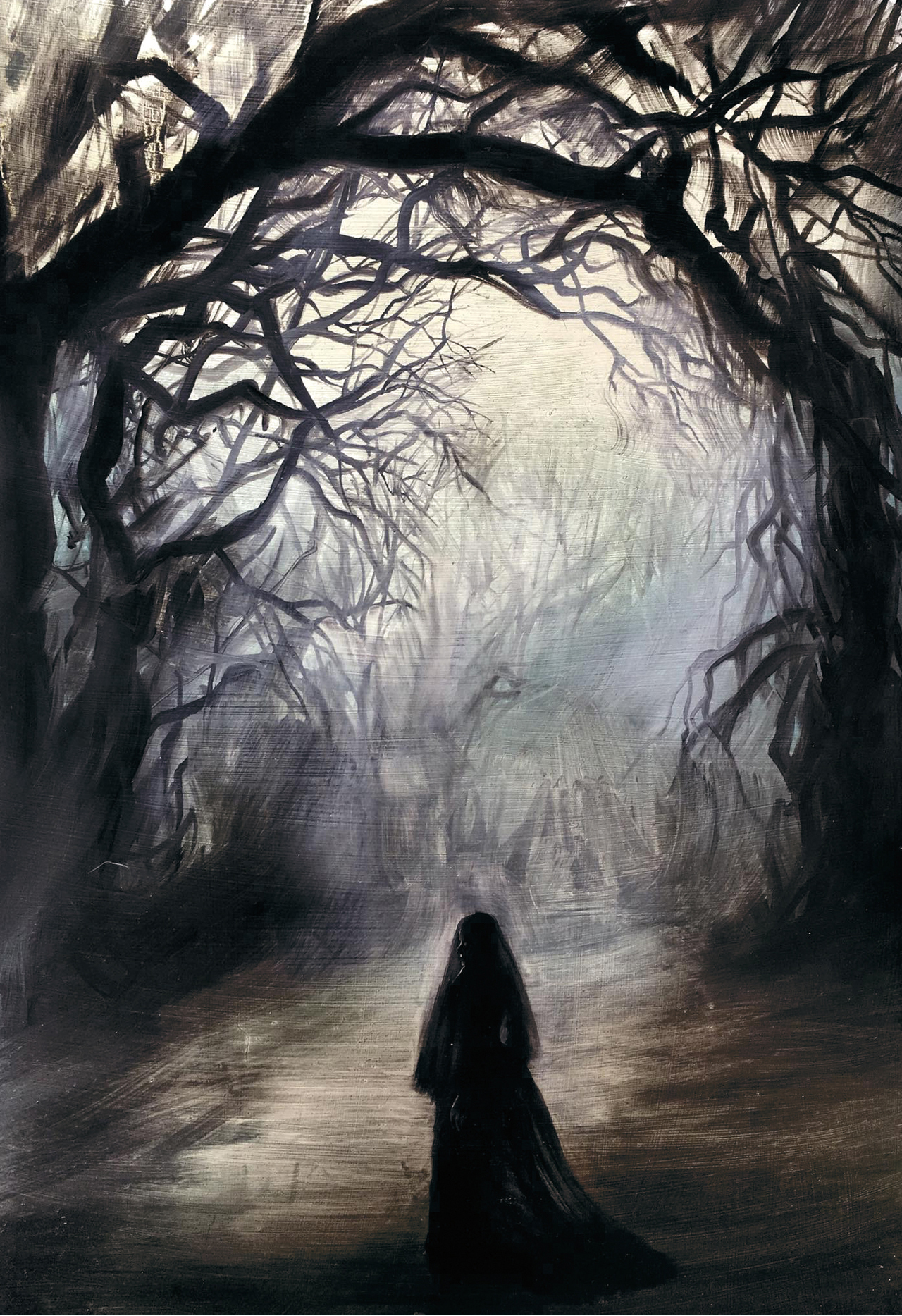
Paulina Karpowicza work from the Carmilla, cycle, 2018/2019, oil on canvas, 43 × 60 cm
Such is the atmosphere of paintings by Łukasz Stokłosa, Paulina Karpowicz, Mikołaj Sobczak, and Mateusz Chudzicki, which are populated by the figures of the most famous undead: vampires. For the romantics, the vampire was one of the main figures of the ghastly imaginary. In her book Wampir. Biografia symboliczna (Vampire. A Symbolic Biography),19 Maria Janion traced the figure, which she claimed to embody the suppressed – and, above all, Slavonic – identity. Janion continued to explore the motif in her Niesamowita słowiańszczyzna (Uncanny Slavdom).20 The scholar came to regard the figure of a vampire/spectre not only as a manifestation of the very work of art (in an extremely suggestive image, somewhat aligned with Oscar Wilde’s 1890 novel The Portrait of Dorian Gray), but most of all as synonymous with a suppressed, unwanted identity.
The latter category becomes the key figure for Piotr Sobolczyk,21 who sees it as queer in character, transgressing the conventions of cultural gender. A similar trope is also indicated by Łukasz Kozak, a scholar researching the emergence of vampires, i.e., our national spectres, who points out that such figures did exist, but often had little in common with their literary counterparts. They were not ‘demonic curiosa’,22 but rather ‘the excluded from among the excluded’,23 that is, persons not falling within a certain canon of norms and behaviour, but also of physicality and appearance.
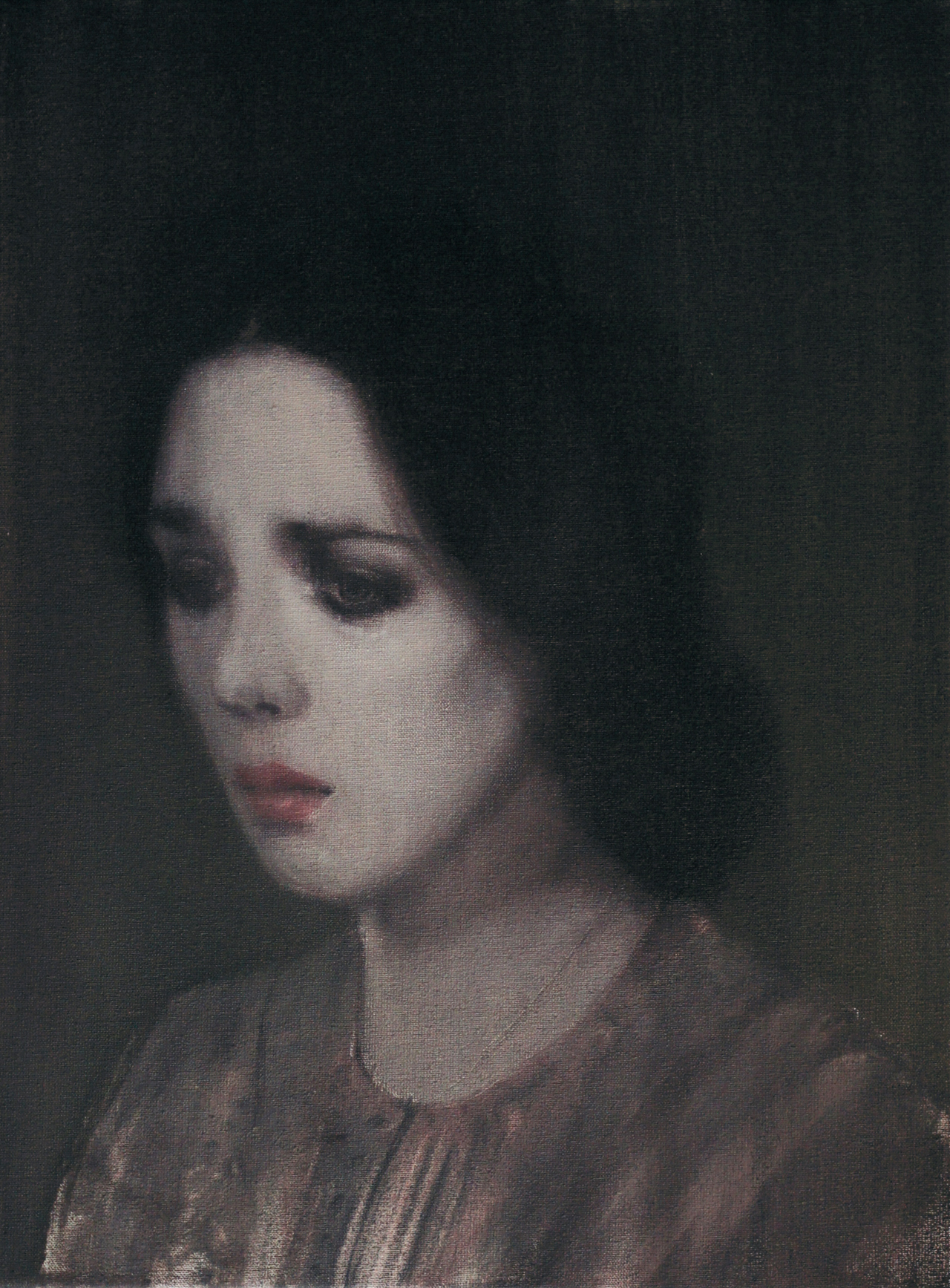
Łukasz Stokłosa, Lucy Harker, Isabelle Adjani, 2014, oil on canvas, 40 × 30 cm
The latter trope appears to be what Mikołaj Sobczak alludes to in his paintings. He is not interested in Western vampires: Dracula, Carmilla or Lord Ruthven, but in our domestic plumards, strigas, and spectres. In his art, Sobczak seemingly follows in the footsteps of Sobolczyk, Kozak, and – to some extent – Janion. His plumard is not a magnate, a nobleman or a French gentleman, nor is he a savage, the barbaric other. He is a tragic character, but in the sense of Francis Ford Coppola’s Dracula, that is, of a tragic existence suspended between life and death. In Sobczak’s art, vampires are persons living on the margins of the Enlightenment world: the crippled, the decrepit, the homosexual, the flawed. Meaning that they do not fit in the canons and norms and elude the conservative and classical worldview.
In the works by Michał Chudzicki, their otherness is further intensified. His representations appear to be balancing between pop culture imagery and folk beliefs. His vampires have sharp teeth dirtied with blood, they seem dangerous and threatening, but at the same time they remain strangely grotesque, crooked, flawed, even defenceless and melancholic.
A similar figure of the vampire has been used by Łukasz Stokłosa and Paulina Karpowicz in their respective works. Stokłosa and Karpowicz refer to the best known pop-culture vampires; however, they tend to select the characters who break out of the stereotypical representations of vampires as emotionless beings, obsessed with drinking blood. In the works of Stokłosa, we may find the likes of: Lucy Harker, played by Isabelle Adjani in Werner Herzog’s Nosferatu (based on the trailblazing vampiric novel Dracula by Bram Stoker), or Louis Pointe du Lac (the role portrayed by Brad Pitt) from Neil Jordan’s movie Interview with a Vampire (based on the novel by Anne Rice of the same title). Karpowicz opts for the – lesser known today – story of the female vampire Carmilla, described by Sheridan le Fanu in the novella Carmilla. Published in 1872, the literary piece was not only a best seller of its times, but also the first so popular depiction of a vampire in a work of literature. Thus, Carmilla was not only older than Count Dracula, but also a female vampire, while her story bore the hallmarks of a lesbian romance-horror.
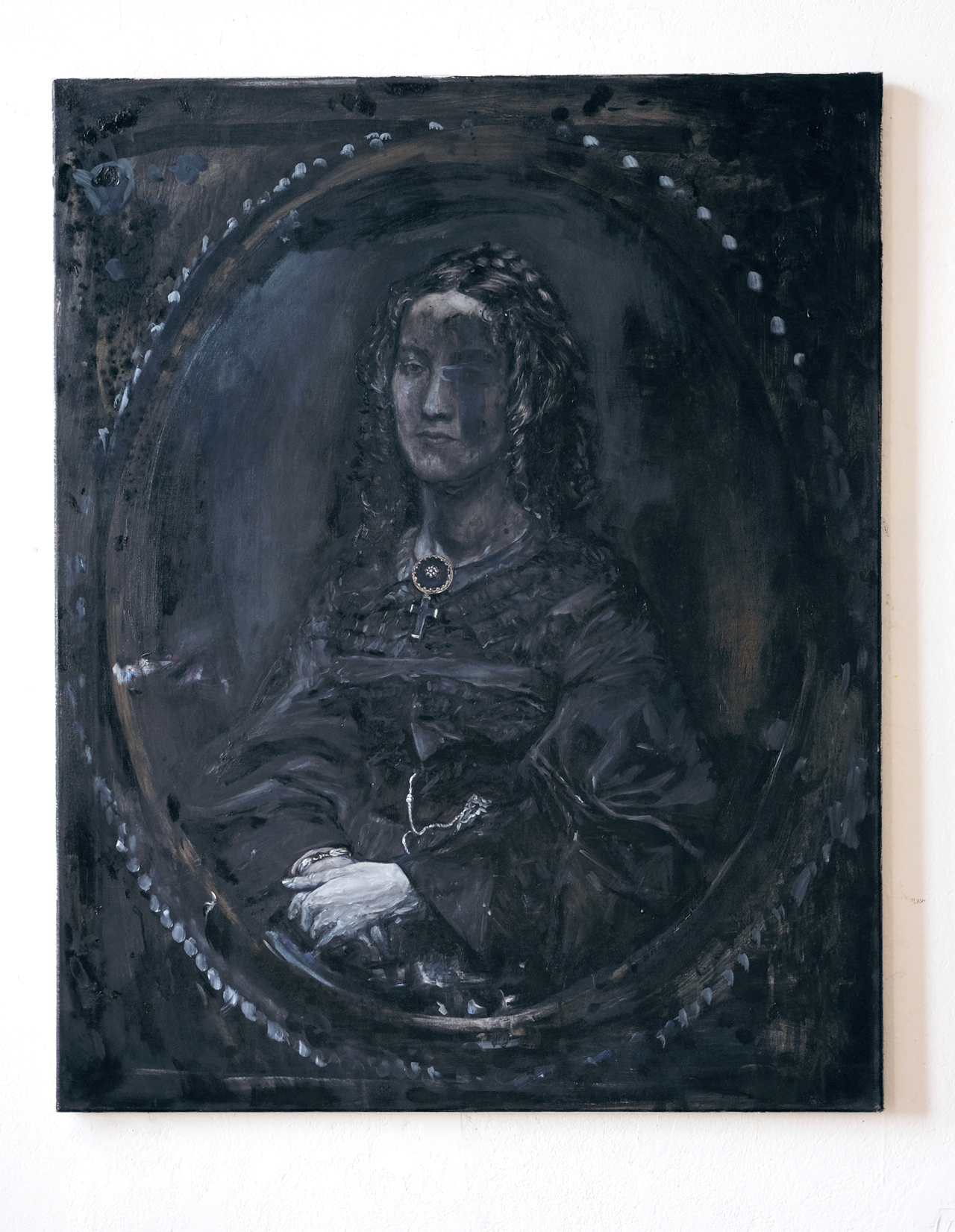
Lena Achtelik, Effigies, 2019, oil on canvas, 110 × 80 cm
Speaking of ghastliness in contemporary art, one cannot overlook the oeuvres of Lena Achtelik, Milena Soporowska, and Dominika Olszowy. Achtelik creates paintings inspired by funerary rituals and customs, post-mortem photography, as well as materiality, perceived as the element manifesting absence and transience. Her paintings seem completely black. On the surface, there spreads a delicate contour looming in the darkness. Watching these works closely, one gets the impression that Achtelik creates mosaics of scraps, using as her material a tangle of leftover stories, trying to recreate a tale from something that fades into darkness by the hour. In a sense, the artist assumes here the role of a medium reproducing in a languid gesture the broken ties connecting our world with the realm of apparitions.
The works of Milena Soporowska give off a similar vibe, as her photographs are filled with most diverse features associated with mediumism: round tables, levitating figures, and sticky ectoplasm dripping out of mouths. This strange jelly-like substance is in constant movement, without determined position in space, with no beginning or end, devoid of origin. It is the Other, the Alien, who lurks everywhere and at the same is nowhere to be found; once expelled, it returns veiled by the night to disturb artificially produced tranquility. Such a mood can also be sensed in some works by Dominika Olszowy, who uses the instruments typical of the spiritist séance.24
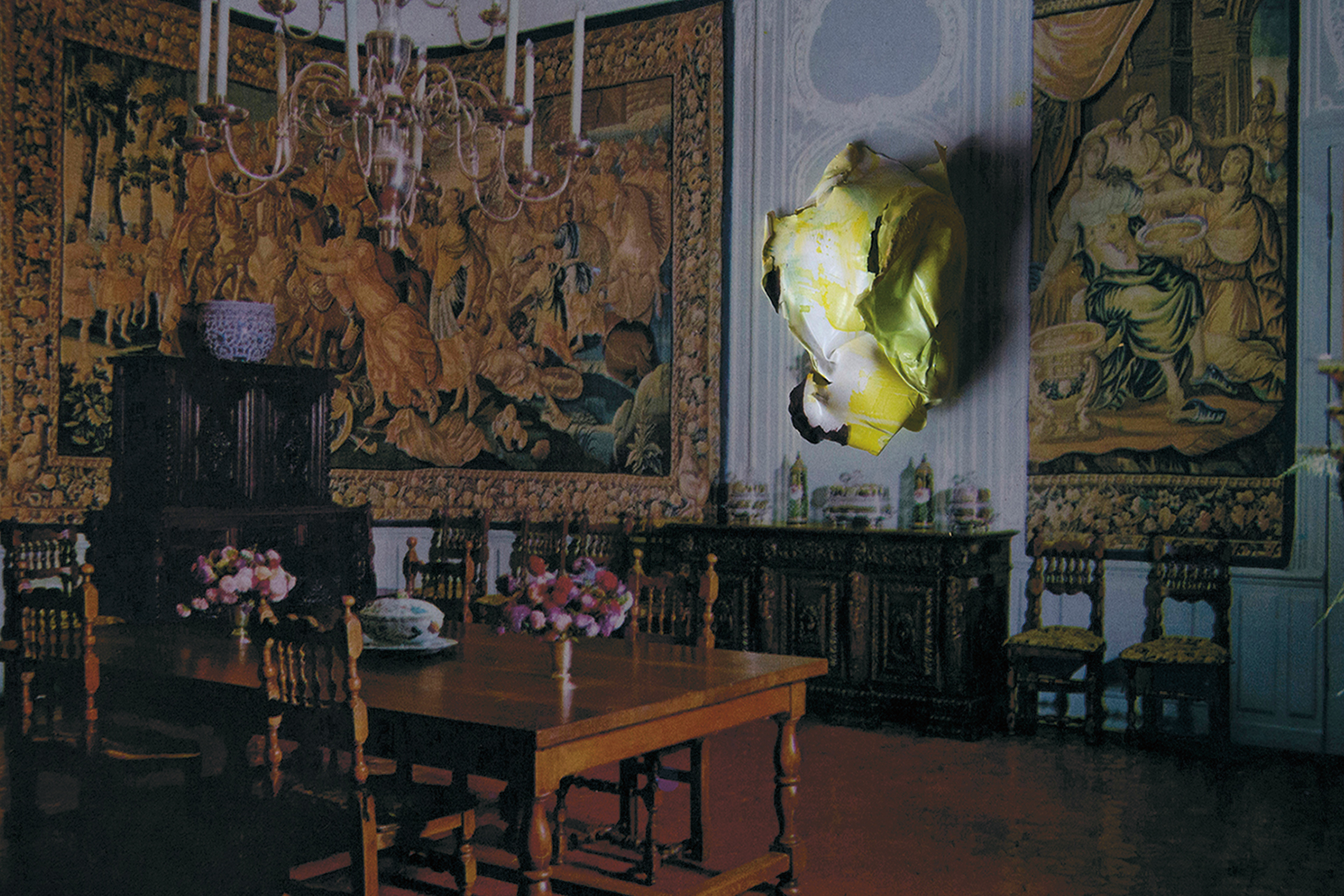 Milena Soporowska, La Salle à Manger, chàteau d’ansouis Vaucluse, (Dining room), 2013
Milena Soporowska, La Salle à Manger, chàteau d’ansouis Vaucluse, (Dining room), 2013
It seems that the figure of the undead, the vampire, the spectre present in contemporary art, or perhaps that of a visiting spirit, sends us today towards a vision of reality as something unbridled, untameable, undomesticable. It is one of the possibilities. However, we can also perceive the figure of the vampire as a metaphor for the complexity of our world. Vampires filled not only with cruelty, nor driven by a demonic power, but also with anything inconsistent with the worldly image, not always impersonating evil. For otherness, diversity, is something that we can draw strength from, but also something we cannot leave behind.
MAGIC
Almost every era in the history of art developed its own particular attitude to arcane sciences as well as to the individuals dabbling in the forbidden knowledge. A figure characteristic of this type of thinking is that of a witch, a crone, who in the recent years has grown in popularity not only due to the influence of pop culture, but mainly owing to feminist movements. Witches appeared in countless romantic ballads that evoked the irrational and surreal content inherent in folk culture. Meanwhile, the latter was ennobled by the generation of early romantics.
For many young female artists, the figure of a witch also becomes an important facet of their artistic identity. Witchcraft – and hence, magic – can be found in the art of Martyna Borowiecka, and Agata Słowak, Małgorzata Wielek-M, Alex Urban, and Aleksandra Waliszewska. Also ‘guys’ admit to having contact with magic, among them: Krzysztof Gil, and Janek Możdżyński. Magic and eeriness serve these female and male artists as a pretext to speak of the reality around us. There is a lot of fragmentariness, corporeality and brutality here, while ghastliness – the characteristic feature of the romantic turn – is mixed with the sense of unfettered power and strength.

Małgorzata Wielek-M Czary mary (Hocus Pocus), 2018, oil on canvas 160 × 110 cm

Martyna Borowiecka 2020, oil on canvas, 160 × 110 cm
The fragmentary bodies in the paintings by Martyna Borowiecka are sinking through the ground, standing petrified, or running away in an unknown direction. For the artist, such fragmentariness becomes the access key to reality, a pretext to maintain balance between what Janion referred to as ‘the world of ghosts’ or ‘the land of imaginings’, and reality.25 For Borowiecka, painting is a perilous activity, diverging from the norm; it is created in a deliberate but slightly visionary rapture, while her works are in part portraits of witches – pangs of conscience of the early rationality and the foundations of modernity.
Alex Urban presents in her paintings the world only at first glance reminiscent of fairy-tales. She uses this seemingly innocent convention to expose violence and sexism. The witches and other fantastical figures inhabiting her universe are taxed not by surreal factors, but by oppressive reality. Whereas Urban opts for slightly fairy-tale like stylistics, Aleksandra Waliszewska, Małgorzata Wielek-M, and Agata Słowak undertake to reconstruct representations associated with dark, stuffy and terrifying aesthetics. Each, through such sharp and clear-cut stylings, hints at the authenticity of the stories presented. For many years, Waliszewska has been weaving her elaborate tale of apparitions, spectral girls dispensing justice to their oppressors or subjecting them to various tortures. Wielek-M presents in her paintings the brutality of a skinned body, thus bringing out the concealed fears and apprehensions. Paintings by Słowak introduce numerous hybrid female characters. The striking feature of her art is its unusual expressiveness, as well as the mood rife with anxiety and tensions. An important element of the tales she tells is a certain rituality that serves as a catalyst for wild instincts and dark desires.
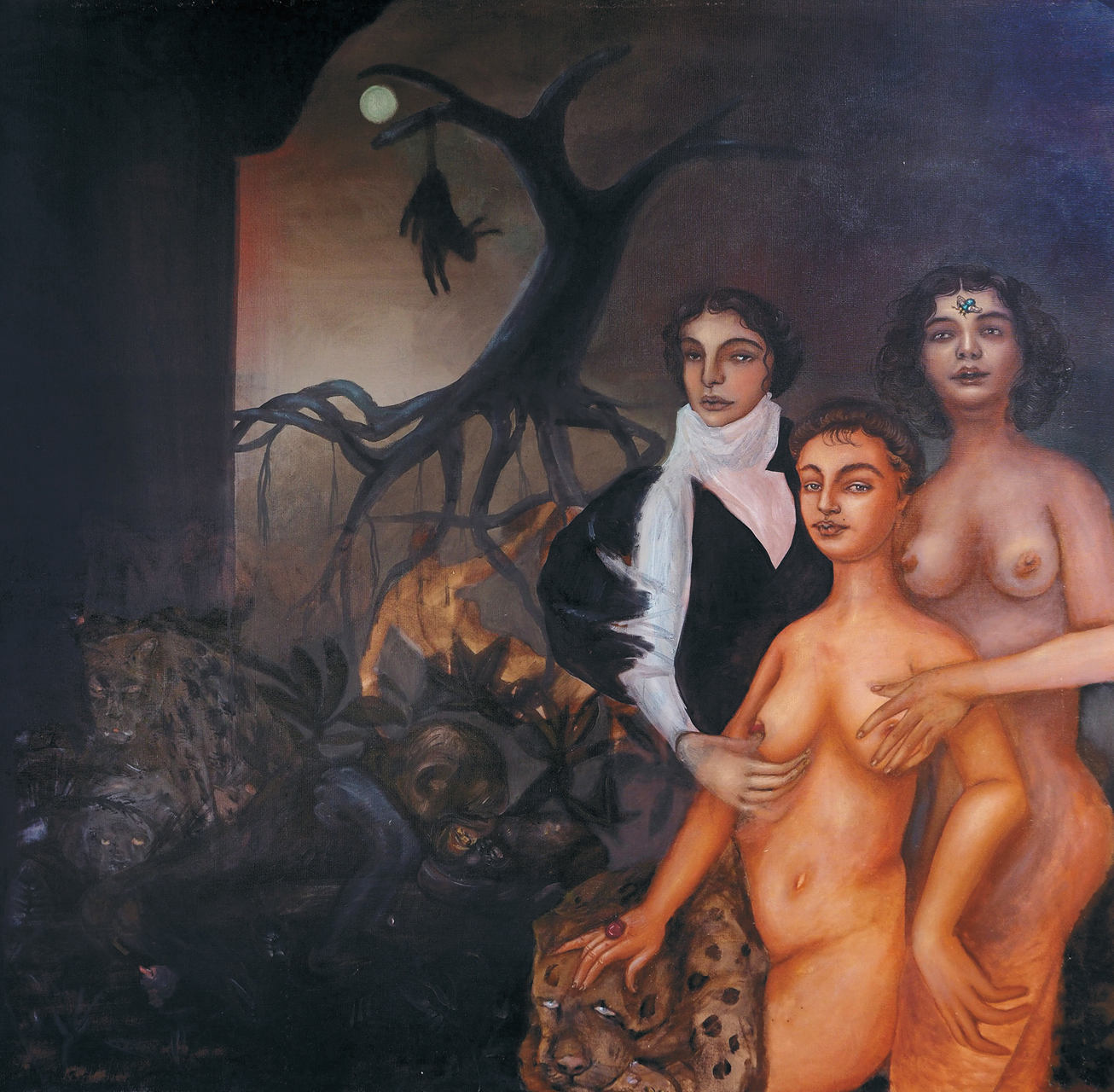
Agata Słowak, Królik ofiarny, 2020, olej na płótnie, 140 × 140 cm
In the works of the female artists mentioned above, one can discern elements of the Gothic novel, rather popular in the romantic period. Female characters in stories of that sort no more than appear to be unambiguous and predictable. It must be emphasised here that at the peak popularity of Gothic novels, it was predominantly women who not only read, but also who wrote them. Stereotypically, a heroine of a Gothic novel tends to be represented as an innocent maiden, tormented and tortured by the Gothic villain, the master of a sinister castle. Meanwhile, on a closer look at the classic Gothic tales, we notice that females can also be villains, executioners, and tormentors. The view is corroborated by such female characters as the aforesaid vampire Carmilla, Comtesse Dolingen of Graz in Styria, Marquise di Vivaldi, or Catherine Earnshaw.
A female character in a Gothic novel is created as the opposite of an overly emotional dame of the Enlightenment period, she starts to develop a rebellious nature, defiant of the society and the divine order. The woman is no longer a doll in the boudoir. No longer the beautiful decoration that she used to be for many years, she becomes the instrument of perverse pleasure, whereas evil and violence come to reap their harvest regardless of who perpetrates them. The result of pleasure is not the overwhelming sense of boredom, but the dark, sticky death, bursting through the appearances of order. Gothic heroines very often encounter perilous adventures in their early youth or at the point when they were deprived of the care of their guardians or parents.26
These young women have to face the dark side of reality that threatens them, the darkness they frequently conceal within themselves. We can find precisely such motifs in the paintings of the artists discussed here.
Likewise in the oeuvres of Krzysztof Gil, and Janek Możdżyński. Both frequently apply magical stylings. In their paintings, we come across witchery, magic, the figure of the Other, the Alien, as well as the magical and fortune-telling instrument, that is, the tarot cards. In fact, both Gil and Możdżyński created several works providing their own interpretation of the Great Arcanum of tarot. As a significant element of his work Gil sees the stylistic references to nineteenth-century painting, but also to the memory – or oblivion – related to the Romani people. In the eyes of the romantics, the popular figure of a gypsy was the incarnation of unbound freedom, but also someone invested with the power to predict the future.
The emergence of magical stylings is likely to have been more than a reaction to the apparent rationalisation of the world, de facto constituting a voice weighing in on the crisis this world is suffering from. Such an attitude inherent in the oeuvre of the female and male artists referred to here is a reflection of the growing weakness of the modernist and Enlightenment thought. The ostentatious gesture of turning away from reality is merely an appearance, for it marks an attempt at a different method of dealing with the problems that surround. The discussed inclination to enchant reality appears to have its roots in a cultural deficiency. We are constantly playing the same role, assuming the same attitudes, aligning within social schemes, we are repeating our failures, whereas magic is the tool which – when imagination is applied – can influence the world.
ROMANTICISM SEMPER VIVUS?
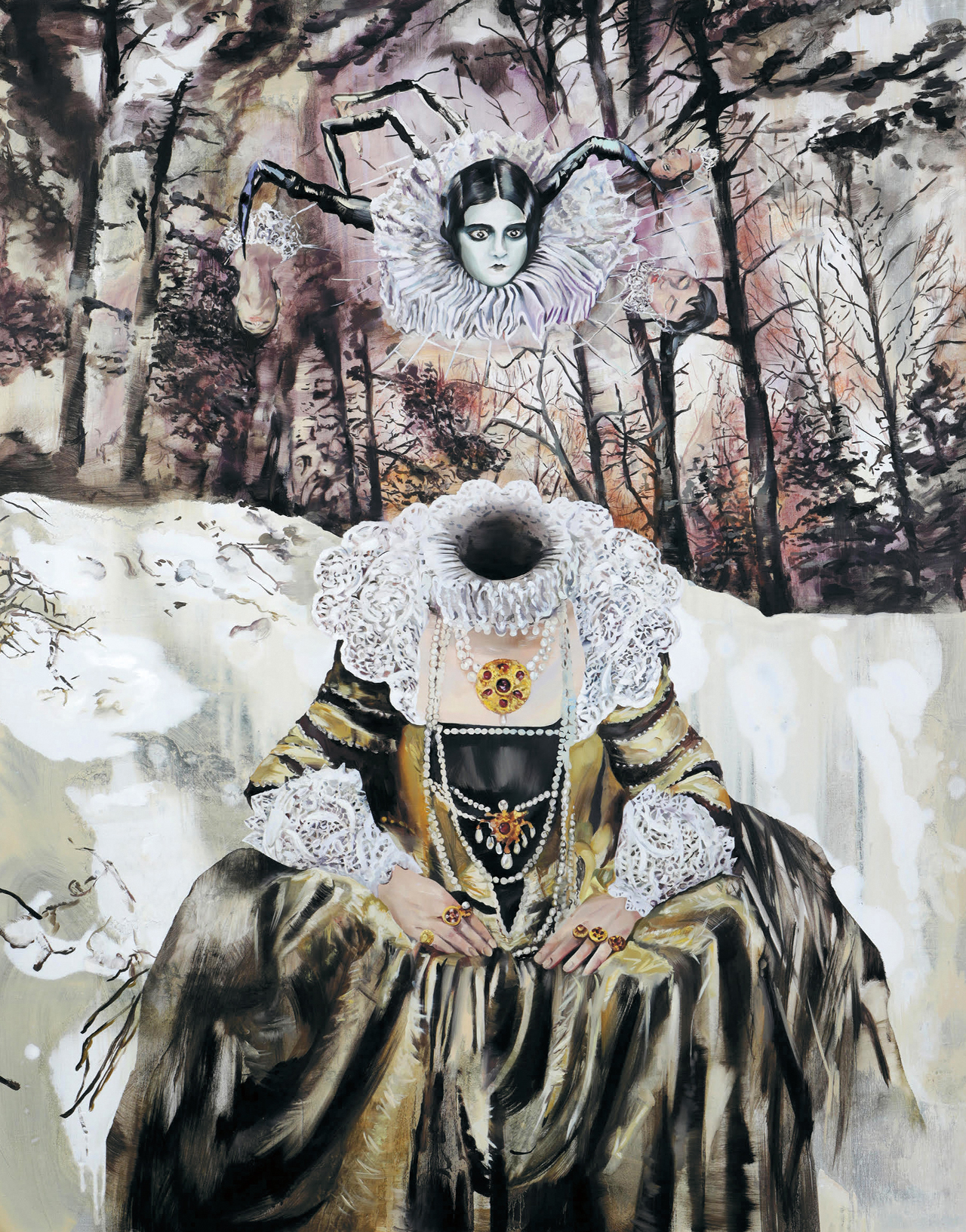
Maja Krysiak-Podsiadlik
Zakorzeniona (Rooted), 2021, oil on canvas, 150 × 120 cm
The issues outlined here are far from being exhausted with the instances cited above. A careful reader is certain to notice that they constitute a rather modest collection of a dozen or so persons, mainly female artists. It may seem decisively too few to speak of a new movement in modern art, to believe that we are witnessing here the coming of a new aesthetics. However, we could find similar associations in the works of Agnieszka Brzeżańska, Olaf Brzeski, Tomasz Kozak, Krzysztof Maniak, Natalia Bażowska, Agata Szymanek, Aleksander Sovtysik, Katarzyna Olma, Basia Bańda, Małgorzata Malwina Niespodziewana, Erwina Ziomkowska, Magdalena Moskwa, Irenka Kalicka, Kamila Moskowczenka, Bianka Rolando, Justyna Górowska, Paulina Ołowska, Aleksandra Liput, Martyna Czech, Izabela Ewa Ołdak, Bartosz Zaskórski, Agata Kus, Krzysztof Grzybacz, Hanna Krzysztofiak, Maciej Nowacki, Veronika Hapchenko, Adam Nehring, Aleksandra Otulska, Jula Kwadro, Małgorzata Markiewicz, Tomasz Kawecki, Szymon Rogiński, Karolina Kowalska, Kaja Redkie, and Mateusz Hajdo.
What looms out of all that is the image of ‘romantic’ attitudes assumed in defence against the category of ‘social engagement’ ever more frequently attributed to art. Which, however, is not to say that the artists are not socially engaged. Indeed, they are, but in an entirely different manner and they manifest it using different artistic means. We can see here references to magic, dread, to a certain sense of nostalgia and other dust-covered romantic attitudes, which prove to be genuinely contemporary and liberating.
The category of the romantic turn I advocate here to a certain extent helps us capture the artistic practice at the intersection of imagination, eerie anthropology and a certain oneiric surplus. The notion not only helps facilitate the identification of phenomena beyond the field of socially engaged and critical art, but also fosters a different perspective of looking at the entire reception of the legacy of Polish romanticism. Contrary to common notions of this period and its style, infantilised in common ideas, the romantic aesthetic constitutes a valid effort to differently account for the contemporary reality. For many artists it constitutes the point of origin for the sense of surfeit with modernity; it may also be perceived as an attempt to challenge the dominating belief in progress and science. The sublime vision of Polish culture and art founded on the commonly accepted image of romanticism is not mirrored in contemporary art, which more and more often focuses on the ‘Gothic’ facet of this heritage. So it is, because the contemporary reality increasingly becomes a field of political games, in which norms, history, and values are being constantly shifted. Thus, art and culture turn into ghost hunters, instruments for detecting eeriness and irrationality, as well as seeking escape alleys from the world filled with pathos and political exorcisms, not to mention wars.
The interest in ghastliness, magic, and dread – as manifested by visual artists – overlaps with the intensification of global economic, ecological, and migratory crises, whereas in the Polish political arena – of messianic proclivities. It seems that at this moment of intensified nationalist tendencies, the old spectres make themselves felt. Those who ‘were not allowed a proper burial’ speak out on their own behalf, as the closet is gradually filled with historical skeletons. The fear of reviving something that was considered dead may become one of the clichés shaping Polish modernity and contemporaneity not only within culture, but also in the social reality, and – above all – the politics of memory. The latter will be for many years to come dominated largely by necromantic practices: symbolic summons of the dead and an endless ritual of Mickiewicz’s Forefather’s Eve. After all, it has long been known that ‘the sleep of reason produces monsters’.
Endnotes
1 For more on this issue, see J. Ławski, Studia o czarnym romantyzmie, Gdańsk: słowo/obraz terytoria, 2008.
2 M. Janion, Projekt krytyki fantazmatycznej, Warszawa: pen, 1991.
3 Eadem, Gorączka romantyczna, Warszawa: piw, 1975, 225–43.
4 Ibid. 26–47.
5 W. Strzemiński, ‘Konieczność walki z upiorami romantyzmu’, in idem, Wybór pism estetycznych, ed. by G. Sztabiński, Kraków: Universitas, 2006, 97–100.
6 P. Stangret, ‘Awangarda wobec romantyzmu’, https://teatr-pismo.pl/5339-awangarda-wobec-romantyzmu/ [accessed: 11 Feb. 2022].
7 J. Banasiak, Zmęczeni rzeczywistością, Warszawa: 40 000 Malarzy, 2009.
8 A. Banach, O polskiej sztuce fantastycznej, Kraków: Wydawnictwo Literackie, 1968.
9 E. Majewska, ‘Między nienawiścią do demokracji a współpracą’, Kultura Współczesna, 2 (2013): 62–78.
10 A. Pyzik, ‘Dziady polskie, czyli o wcieleniach niesamowitego w polskiej kulturze’, Obieg, 1–2 (2008): 152–73.
11 A. Mazur, ‘Zwyczajne niesamowite’, Obieg, 1–2 (2008): 185–201.
12 I. Kowalczyk, ‘Duchy, upiory, wampiry’, Obieg,2 (2006): 34–40.
13 M. Janion, M. Żmigrodzka, Romantyzm i historia, Warszawa: piw, 1978.
14 M. Janion, Odnawianie znaczeń, Kraków: Wydawnictwo Literackie, 1978.
15 For instance, his Novus Ordo Seclorum cycle.
16 M. Kudelska, ‘In Pursuit of the Black Square. Interview with Jakub Woynarowski’, Contemporary Lynx, https://contemporarylynx.co.uk/in-pursuit-of-the-black-square [accessed 10 Oct. 2021].
17 M. Kudelska, ‘The World’s Oddity. In Conversation with Wojciech Ireneusz Sobczyk’, Contemporary Lynx, https://contemporarylynx.co.uk/the-worlds–oddity-in-conversation-with-wojtek-ireneusz-sobczyk [accessed 10 Oct. 2021].
18 S. Žižek, Patrząc z ukosa. Do Lacana przez kulturę popularną, transl. to Polish by J. Margański, Warszawa: Aletheia, 2003, 42; [English edition: Looking Awry. An Introduction to Jacques Lacan through Popular Culture, Cambridge (ma): MIT, 1992].
19 M. Janion, Wampir. Biografia symboliczna, Gdańsk: słowo/obraz terytoria, 2002.
20 Eadem, Niesamowita słowiańszczyzna, Kraków: Wydawnictwo Literackie, 2006.
21 P. Sobolczyk, Gotycyzm – modernistyczny sobowtór odmieńca, Gdańsk: słowo/obraz terytoria, 2017.
22 Ł. Kozak, Upiór, Warszawa: Fundacja Evviva L’Arte, 2020, 18.
23 Ibid. 15.
24 For more on the art of Lena Achtelik, Milena Soporowska, and Dominika Olszowy in the context of spiritism, see: M. Kudelska, ‘Mediumistki, widma i zjawy. Nadrealne strategie w sztuce polskich artystek’,in Brakujący element. Wątki ezoteryczne w sztuce współczesnej, J. Kaiser and J. Woynarowski (eds.), Kraków: ASP, 2022.
25 M. Janion, Projekt krytyki fantazmatycznej, op. cit., 8.
26 A. Andrusiewicz, ‘Transformacje kobiety w gotycyzmie. Kulturowa feminizacja zła’,Annales Academiae Paedagogicae Cracoviensis. Studia Sociologica, 54 (2008): 60–8.
Bibliography
-
Andrusiewicz A, ‘Transformacje kobiety w gotycyzmie. Kulturowa feminizacja zła’, Annales Academiae Paedagogicae Cracoviensis. Studia Sociologica, 54 (2008): 60–8.
-
Banach A., O polskiej sztuce fantastycznej, Kraków: Wydawnictwo Literackie, 1968.
-
Banasiak J., Zmęczeni rzeczywistością, Warszawa: 40 000 Malarzy, 2009.
-
Janion M., Gorączka romantyczna, Warszawa: piw, 1975.
-
Janion M., Niesamowita słowiańszczyzna, Kraków: Wydawnictwo Literackie, 2006.
-
Janion M., Odnawianie znaczeń, Kraków: Wydawnictwo Literackie, 1978.
-
Janion M., Projekt krytyki fantazmatycznej, Warszawa: pen, 1991.
-
Janion M., Wampir. Biografia symboliczna, Gdańsk: słowo/obraz terytoria, 2002.
-
Janion M., Żmigrodzka M., Romantyzm i historia, Warszawa: piw, 1978.
-
Ławski J., Studia o czarnym romantyzmie, Gdańsk: słowo/obraz terytoria, 2008.
-
Kowalczyk I., ‘Duchy, upiory, wampiry’, Obieg, 2 (2006): 34–40.
-
Kudelska M., ‘In Pursuit of the Black Square. Interview with Jakub Woynarowski’, Contemporary Lynx, https://contemporarylynx.co.uk/in-pursuit-of-the-black-square [accessed 10 Oct. 2021].
-
Kudelska M., ‘The Worlds Oddity. In Conversation with Wojciech Ireneusz Sobczyk’, Contemporary Lynx, https://contemporarylynx.co.uk/the-worlds-oddity-in-conversation-with-wojtek-ire-neusz-sobczyk [accessed 10 Oct. 2021].
-
Kudelska M., ‘Mediumistki, widma i zjawy – nadrealne strategie w sztuce polskich artystek’ in Brakujący element. Wątki ezoteryczne w sztuce współczesnej, J. Kaiser, J. Woynarowski (eds.), Kraków: asp, 2022.
-
Kozak Ł., Upiór, Warszawa: Fundacja Evviva L’Arte, 2020.
-
Majewska E., ‘Między nienawiścią do demokracji a współpracą’, Kultura Współczesna, 2 (2013): 62–78.
-
Mazur A., ‘Zwyczajne niesamowite’, Obieg, 1–2 (2008): 185–201.
-
Pyzik A., ‘Dziady polskie, czyli o wcieleniach niesamowitego w polskiej kulturze’, Obieg, 1–2 (2008): 152–73.
-
Sobolczyk P., Gotycyzm – modernistyczny sobowtór odmieńca, Gdańsk: słowo/obraz terytoria, 2017.
-
Strzemiński W., Wybór pism estetycznych, G. Sztabiński (ed.), Kraków: Universitas, 2006.
-
Žižek S., Patrząc z ukosa. Do Lacana przez kulturę popularną, transl. to Polish by J. Margański, Warszawa: Aletheia, 2003. [English edition: Looking Awry. An Introduction to Jacques Lacan through Popular Culture, Cambridge (ma): mit, 1992]
Marta Kudelska
Curator and art critic. Member of the Polish Section of the International Association of Art Critics (aica). She majored in Culture Studies with a speciality in Modern Culture, and the History of Art at Jagiellonian University in Krakow.
Currently working on a doctoral dissertation on the strategies used by young art curators active in the area of Katowice and Krakow. She is interested in memory, reflection about art institutions, curatorial practice, young art, as well as the ties between modern art and phenomena such as: dread, spectrology, magic, and the romantic tradition. She is employed as an assistant in the Chair of Contemporary Culture at the Institute of Culture at Jagiellonian University.
orcid: 0000-0001-5436-3075



